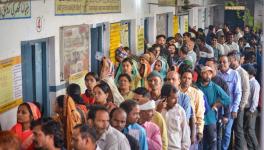This is Not Really Democracy But Its Poor Caricature
The sweeping victory of the AAP in Delhi in the teeth of a vicious and overpowering campaign of religion-based propaganda by a phalanx of BJP leaders who spewed excoriating communal venom is a matter of relief.
That Delhi Chief Minister Arvind Kejriwal patiently ignored such provocation and retained the trust of Delhi’s voters in spite of BJP vote-share steeply climbing to 39% is a testimony to his tactical skills and the strength of his convictions.
What puzzles observers is Kejriwal’s overt overtures to the Hindutva camp through pious intonation of the Hanuman Chalisa. There appears to be nothing on the ground to explain this unexpected manoeuvre.
Does he want to stress that he does not belong to the camp of ideological opponents of Hindutva? Or does he hope to obviate or disarm the inevitable retaliatory attack by the BJP government at the Centre in times ahead? Is he trying to reassure the rising numbers of Hindutva zealots in the capital that they need not worry? Or is it the opening of a new chapter?
Hence, the non-ideological project of pure governance, oiling and refitting the machine of government to fulfil its given design of governing more efficiently and economically to the satisfaction of its specific target-consumers, needs a close scrutiny. This is a sad, if unavoidable, necessity.
The AAP model cannot, I think, be easily replicated in many other states. It will be difficult to organise at short notice a battalion of professionally minded, skilled and dedicated workers disgusted with the habitual corruption and inefficiency of governments. Apart from Kejriwal’s own shrewd and energetic leadership this has been the legacy of the now-forgotten anti-corruption movement of Anna Hazare.
Besides there is the question of dimensions. Delhi is a much smaller and less varied unit than most other states, much better integrated by communication chains too, making it easier to reach out and persuade people as also check the veracity of the claims of rival parties on the ground.
But the biggest difference is that Kejriwal got away by skirting over-riding national issues, a method rather unlikely to succeed elsewhere. Besides, at a time when the very nature of our state and Constitution is at stake, will it be advisable to pitch for only an efficient, corruption-free government floating high above such debates? The temptation is naturally strong. But to succumb to it may in the long run do more harm than good to the country.
Influential voices, both in Assam and elsewhere in the country, have started murmuring that the anti-CAA stir in Assam is in a different class altogether than that in the rest of the country. While Assam is concerned to preserve the identity of the indigenous people, the argument goes, the movement elsewhere is is oriented towards upholding the secular values of our Constitution.
It is true that in Assam the people in the movement are battling a unique historical liability while in other states the aim is to resist the vicious obduracy of the government in launching an highly divisive and malevolent programme that will endanger the secular and hence democratic nature of the state itself.
But the point to underline is that the CAA is being steam-rolled by the same force all over the country intent on dividing people into antagonistic groups.
This objective is being pursued with a brutal unconcern for the anxieties of the people, their doubts, questions and distrust of the policies of the government. Any criticism, dissent or resistance, however peaceful and non-violent, is branded as ‘anti-national’. The subjectivity of citizens is being ruthlessly suppressed: they are either beneficiaries loyal to the government and the governing party, or plain enemies. This is true of Assam as well as of other states.
Hence all the unrest and resistance in the streets have a common aim, that of wresting back for the people their power to influence the rulers.
It is arrant nonsense to say that the resistance is incited by Pakistan or forces in league with Pakistan. People want India to remain the country they have known and not turn into a strange overheated tropical marsh clouded with vapours of mistrust, hatred and enmity.
In this context it is pertinent to ask whether the right of the people to assemble and protest is still regarded as a valued democratic right. It has become the rule to get permission of rulers for subject, venue and time of any public programme these days. The administration has acquired the right to declare any assembly unlawful and rule out any venue for a meeting, rally or demonstration. Thus the expressions of public protest remain ‘peaceful’, ‘democratic’ and ahem! rather favourable to government’s assumption of untrammelled power. Spontaneous outbursts of popular passion are all clubbed together as mob violence, irrespective of their content. No, this is not really democracy but its poor caricature.
The writer is a literary critic and commentator on socio-political issues. The views are personal.
Get the latest reports & analysis with people's perspective on Protests, movements & deep analytical videos, discussions of the current affairs in your Telegram app. Subscribe to NewsClick's Telegram channel & get Real-Time updates on stories, as they get published on our website.
























